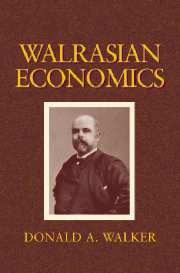Book contents
- Frontmatter
- Contents
- Preface
- Introduction
- Part I Walras's ideas
- 1 General philosophy and methodology
- 2 Economic philosophy and methodology
- 3 Methods of evaluation of economic theory
- 4 Human nature
- 5 Basic sub-models
- 6 Rationale for the written pledges sketch and its characteristics
- 7 Some bibliographical remarks
- 8 The definitive bibliography of the writings of Léon Walras
- Part II Walras's influence
- References
- References and Bibliography for Chapter 11
- Index
2 - Economic philosophy and methodology
Published online by Cambridge University Press: 02 September 2009
- Frontmatter
- Contents
- Preface
- Introduction
- Part I Walras's ideas
- 1 General philosophy and methodology
- 2 Economic philosophy and methodology
- 3 Methods of evaluation of economic theory
- 4 Human nature
- 5 Basic sub-models
- 6 Rationale for the written pledges sketch and its characteristics
- 7 Some bibliographical remarks
- 8 The definitive bibliography of the writings of Léon Walras
- Part II Walras's influence
- References
- References and Bibliography for Chapter 11
- Index
Summary
In this chapter and the following one Walras's economic philosophy and methodology are discussed. They are special aspects of the general philosophical and methodological views that he developed during the creative and mature phases of his theoretical activity. He drew most of his ideas about economic philosophy and methodology from the work of his predecessors, including his father, J.-B. Say, J. S. Mill, A.-A. Cournot, and others mentioned in Chapter 1, and from Pelegrino Rossi (Diemer 2002) and Jules Dupuit (ibid). In regard to the specific features of his economic theorizing, Walras's beliefs about economic science were the same as those of many other important economists, such as those mentioned above, in the respects that will be indicated in this chapter. He tried to implement the methodological ideas of nineteenth-century physical scientists – which were not the same thing as their mechanics or their physics. They, of course, were indebted for many of their methodological ideas to the scientists of previous periods. Whatever their origins, Walras's methodological practices, his use of mathematics, and his modeling techniques were far in advance of anything that economists in centuries previous to his own could have imagined.
Walras's ideas about how to undertake economic theorizing, implemented in his mature comprehensive model of general equilibration and equilibrium, constitute a system of economic methodological thought designed to achieve his goal of understanding the economy of his time. The system can be seen to be constituted of a carefully reasoned logical sequence of steps.
- Type
- Chapter
- Information
- Walrasian Economics , pp. 58 - 84Publisher: Cambridge University PressPrint publication year: 2006



